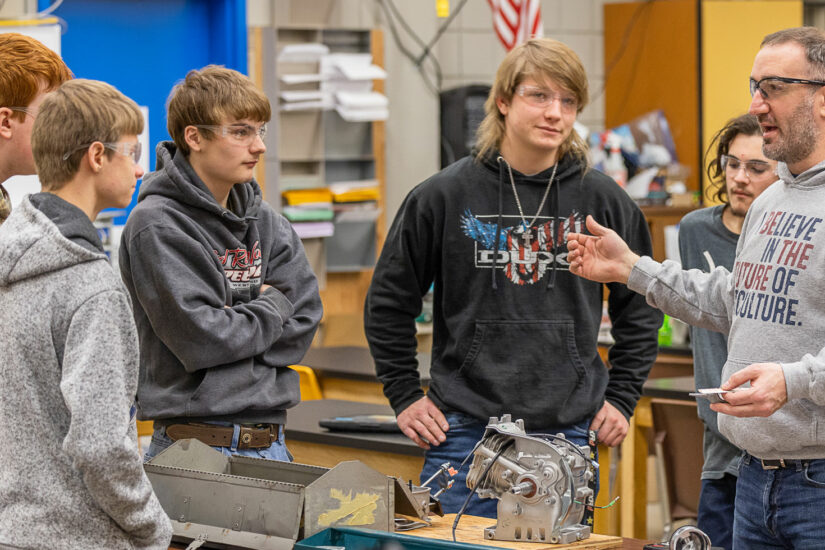
Where Science Soars
Two teachers are bringing NASA-inspired innovation into their classrooms
By Joy Baker | Photography by John Linn
Two Central Minnesota science teachers are literally taking their teaching out of this world. Braham High School’s Luke Becker and Pequot Lakes High School’s Joshua Borchardt are taking Science, Technology, Engineering and Math (STEM) to the edge of space.
Becker, an ag science and technology teacher, was named National Teacher of the Year in November 2021 by the Association for Career and Technical Education. He leads the NASA HUNCH Design Team (High school students United with NASA to Construct Hardware) at Braham High School and is pushing his students to the outer limits with future-inspired projects that are attracting the interest of NASA engineers.
For the past three years, Becker’s students were tasked with designing a zero-gravity washing machine so NASA astronauts could wash their clothes in space. They’ve also worked on a scale model of the International Space Station’s Destiny module to be used as an exhibit at U.S. airports. Yet another project was a magnetic boot that would allow astronauts to adhere to the surface of the spaceship and walk rather than float in zero gravity. In addition to leading the HUNCH Design Team, Becker also leads the school’s Supermileage Team. Each year, this group of students designs and constructs a fuel-efficient, hyper-mileage vehicle to compete at the Shell Eco-Marathon, held each April at the Indianapolis Motor Speedway.
Becker is always looking for ways to enrich his teaching, which is why he was excited to learn about a $7,500 wind tunnel that wasn’t being used and was just taking up space in his friend’s shop. “He told me, ‘If you want it, it’s yours,’” Becker said.
The wind tunnel would be perfect for testing prototypes for the Supermileage Team. The only problem was the wind tunnel was built for rockets, not cars. So to meet their needs, it would require a much more complex sensor. The sensor would help determine any lift or down-force on the axles, how much force was being blown onto the car, and how much drag is produced.
Becker applied for a grant through the Braham Area Education Foundation, an Initiative Foundation-hosted Partner Fund, to purchase the ideal sensor—one that would allow the Supermileage Team to test 3D-printed models for efficiency and aerodynamics while another group of students could test for speed and stability.
Over the years, Becker has helped many students find a passion—and connections—in STEM fields. “As long as they find something they can enjoy, make a career, and have a good life, that’s really all I’m trying to do,” he said. “And if I can provide students with a line on their resume that says, ‘I designed something for NASA and it’s in space,’ that’s really pretty cool.”

STELLAR STEM
In Pequot Lakes, Borchardt credits his graduate studies as a high-altitude balloon judge at North Dakota’s NASA Space Grant Consortium for the innovation he now brings to his own classroom.
Borchardt leads the Patriot CubeSat Program at Pequot Lakes High School. Using grant funds he received from the Patriot Foundation, an Initiative Foundation-hosted Partner Fund that serves the Pequot Lakes school district, he’ll teach students how to design, build, launch and recover their own miniature NASA satellites.
“Our students have a great work ethic and come from a mix of backgrounds,” Borchardt said. “Some have programming experience, some don’t, but they’re all in the club together helping each other out. For a teacher, that’s the best thing to see.”
The group is working on eight satellites that are about the size and shape of a pop can. Each student, or small group, will receive their own satellite and be able to act as their own mission control.
“With eight satellites, each student is in charge of the whole process,” Borchardt said—from programming, assembling and designing to doing lab simulations, including entry, descent and parachute-aided landing procedures to ensure a safe landing. “It’s much more of a hands-on experience than having to share one satellite for the whole group.”
All eight satellites, along with a virtual reality camera, will be attached to a high-altitude balloon and then launched from NASA’s Space Grant Consortium at either the University of North Dakota or the University of Minnesota. The camera, also funded by a Patriot Foundation grant, will allow students to see their satellites leaving Earth, rising to the edge of the atmosphere at 110,000 to 130,000 feet, and then—the big highlight—they’ll see the balloon pop.
“At that point, they’ll get to see the darkness of space, the curvature of the Earth, the blue hues. It really looks like you’re in space,” Borchardt said.
On descent, a small parachute will deploy and carry the satellite back to Earth. With assistance from Federal Aviation Administration (FAA) software that calculates ascent rate and atmospheric conditions, the students should be able to zero in on the satellite’s landing site. Once recovered, they’ll bring it back to the classroom for discussion and further analysis.
Although this is Borchardt’s sixth launch as an educator, it will be the first for his Pequot Lakes students.
“A cool thing about the space community is that it’s pretty integrated into the global community,” said Borchardt. “One of my long-term goals is to have a distance partner with a teacher from a country like France, Nigeria, Israel, or China and be able to collaborate as an international team.”
While that goal may still be a few years out, Borchardt said his immediate goal is simpler. “I want to build people up, build new opportunities and build experiences,” he said. “And make sure it’s fun.”